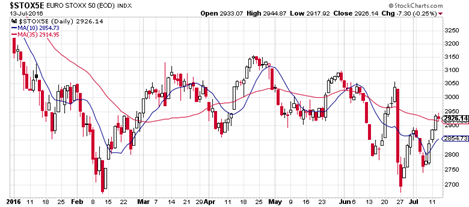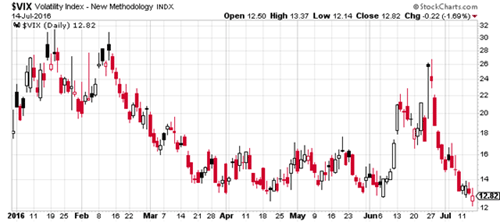I’ll deal with markets first, before getting into history and politics. I want to take you back to the point Jim Rickards made yesterday about the European Union being stronger without the UK. But I want to look at it in terms of an investment idea.
The Euro Stoxx 50 is an index of 50 European-based blue chip stocks. It’s made up of what the index calls “super sector” leaders. These are the biggest and best of their kind, in theory. If you were betting on a resurgent eurozone economy under German leadership in a post-Brexit world, it’s the sort of thing you’d want to take a look at.
What you’ll see are companies from 12 countries. But over half of them are from France and Germany, with Spain, the Netherlands, and Italy being well represented. The super sectors are the usual suspects: banks, insurance, technology, utilities, food and beverage, chemicals, retail, healthcare, oil and gas, media, industrial, construction and materials, and automobiles. Now look at the chart below.

The index made a low in February of this year and tested it post-Brexit. But earlier in the month it crossed the 10-day moving average, and later this week it crossed the 50-day moving average. If it can hold that, and if the 10-day crosses the 35-day, you’ll have some nice short-term momentum.
That momentum would square with the point Jim made yesterday about Chinese capital preferring a German-led EU to other ports of call (like London and New York). Markets are supposed to lead the economy. And so it will be worth keeping an eye on this index to see if it tells you anything useful.
Mind you, there’s a fair bit of political uncertainty in Europe that won’t be resolved until late 2017. You have French national elections in April and May of next year. Then German elections in October. Given Brexit, the spate of attacks in French cities, and Angela Merkel’s unpopular position on migration, it’s quite possible the EU and the eurozone will be even more unstable this time next year. But if prices are reliable signals, this one is worth watching.
VIX depressed, S&P manic
While I’m on the subject of signals (encroaching on Tim Price’s territory at the London Investment Alert) what should you make of the S&P 500 making new highs? It’s stacked on $2 trillion in market value after the Brexit lows. It’s risen 9 of the last 11 days. And if prices are signals, the S&P could be telling you that once you get past the headlines, the world is actually getting better and more prosperous.
It would be the first time a bull market climbed the proverbial “wall of worry.” But inside my head, this feels more like a giant “wave of worry.” And a wave that hasn’t crested yet but will gather speed and height as it rushes to the shore. But what do I mean?
Just what I’ve mentioned here in the past: automation, debt accumulation, and demography are all conspiring against global growth. For companies who make money globally, like those listed in the S&P 500 and the Euro Stoxx 50, being global is a blessing and a curse.
It’s a blessing because it means their revenue streams are diversified. They make money in lots of places, not just one place (this is why the FTSE 100 has outperformed the FTSE 250 post-Brexit). But that means they are also exposed to multiple risks, not the least of which is coping with fluctuating currency values and increasing global trade tensions.
Then there’s the simple “weight of money” argument. The S&P 500, like the 10-year US Treasury market, is benefitting from capital flow. Scared money seeks safety and liquidity. Blue chips and bonds offer both. But capital in flight is not what bull markets are made of, is it? After all, take a look at how quiet the volatility index (VIX) is.

The VIX is derived from options prices. It tells you when people are insuring themselves against a big fall in stocks. The trouble is, it’s always a lagging indicator. Investors are human. And for that reason, many of them only buy insurance after there’s a fire. The VIX spikes after a crisis, not before it.
In a counter-intuitive way, then, a quiet VIX is more alarming than a spiking VIX. It’s too late to flee Vesuvius after the mountain has blown. It’s when it’s dormant for a long time that you really have to worry. Should you worry now?
For nearly 20 years, I’ve observed that financial markets putter along in the summer. All the really good crises happen in September and October. Maybe it’s because nobody likes a crisis while they’re at the beach. Most big markets being in the northern hemisphere; July and August are usually quiet.
But underneath the surface, you can be sure there are some terrible tensions. The Italian banking sector is one of them. Chinese debt is another. You have vile terrorism in France. And you have the prospect of violent civil unrest at the American political conventions. That brings me to a final point.
The rhythm of history
Prices move in a rhythm through history. That’s David Hackett Fischer’s claim in his brilliant book The Great Wave: Price Revolutions and the Rhythm of History. He says that the wave has three stages: a revolution in prices, a revolutionary crisis which ushers in an new era, and then a period of stability he calls an equilibrium.
Fischer claims there have been four great waves since the first one in the 13th century. There was another in the 16th century during the Renaissance. Another in the 18th century, which eventually gave way to the “Victorian equilibrium.” And then finally the price revolution of the 20th century, which you and I are living through now.
Were there price waves before that? If there were, they weren’t noticeable or measurable. And it’s probably because over the last 2,000 years (and especially the last 200) advance in GDP per-capita – or just plain advances in wealth via surplus time and capital – were vanishingly small.
Exploration, technology, and population growth have all combined to create noticeable cycles of growth. Whether you call them progress depends on your perspective. I certainly view them as progress. But it’s not linear. It’s cyclical. Which begs the question… where are we now in the cycle?
Automation is replacing thinking jobs today the way it replaced manual labour for the last 200 years. Labour-saving devices are enjoying exponential growth. Meanwhile, the prices of labour, capital, energy, and raw materials have all declined in the last 20 years. How?
China joined the World Trade Organisation (WTO) in late 2001. This unleashed a wave of manufactured goods on the world. But it also, along with India, ushered several billion people into the global labour pool. Those who lost their manufacturing jobs in the West (and lifetime employment) were, at least for a time, able to make up for it with government benefits and/or credit.
But the wave is cresting now. Technology is challenging how we define money. Yet much of the world’s wealth is tied up in debt. Fiscal and monetary policy have stimulated and brought forward as much growth as they can. And now the economy meanders along while political tensions boil over.
Category: Market updates

